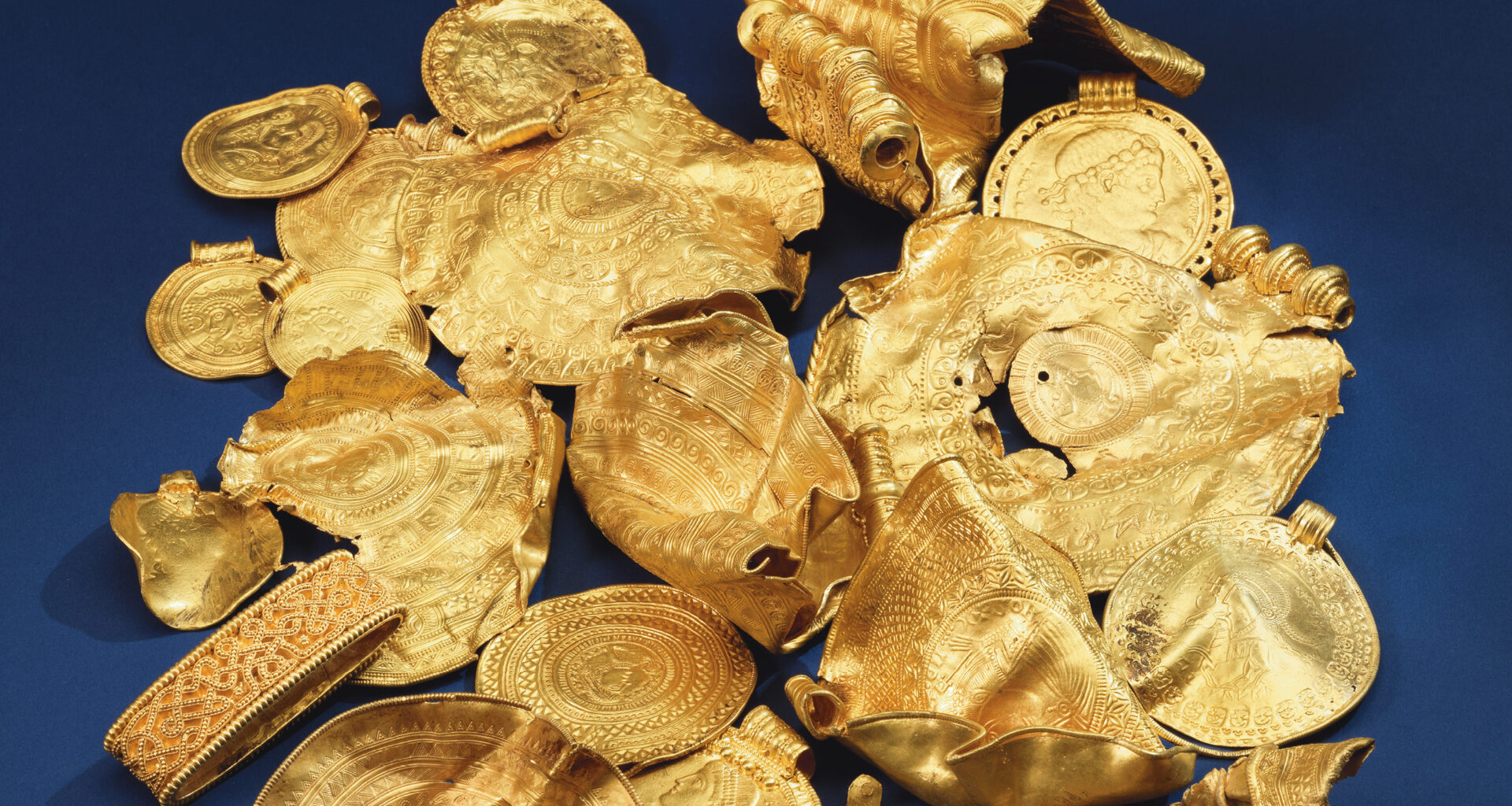Subscribe now for full access and no adverts
Beneath a patch of farmland in central Jutland, Denmark, something extraordinary lay hidden for over 1,500 years. When metal-detectorists uncovered the first glint of gold in December 2020 near the village of Vindelev, they had no idea that they were standing above one of the most remarkable hoards ever found in Scandinavia. The Vindelev Hoard – a collection of gold artefacts including locally produced pendants decorated on one side that are known as bracteates, Roman medallions, and elaborate fittings – opens a window on to a world of powerful elites, far-reaching cultural connections, and symbolic expressions of wealth and religion in Northern Europe during the 4th to 6th centuries AD.
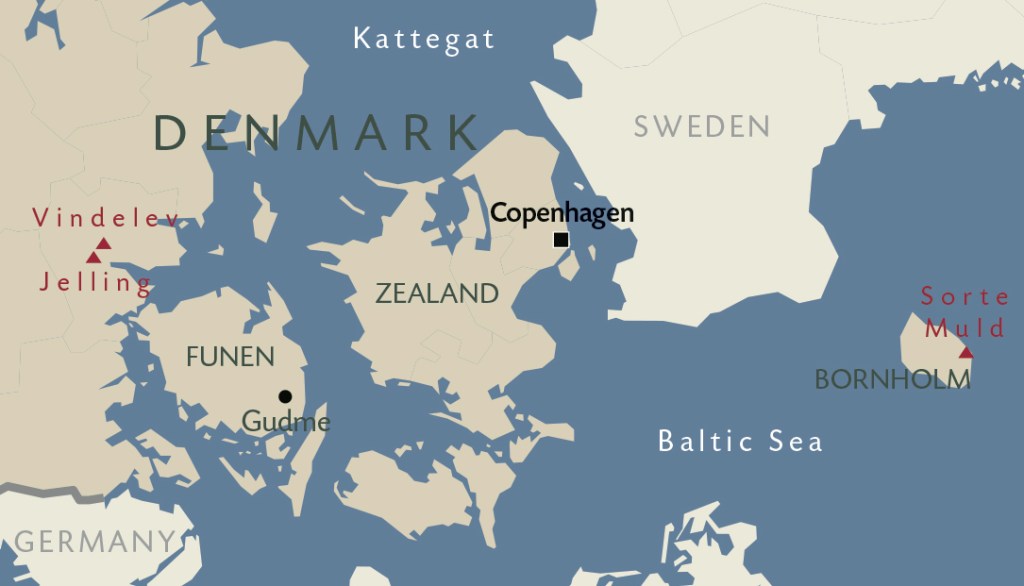
What kind of society buried such treasures – and why? What do these objects tell us about the dynamics of individual and group identity, or about cultural influences and religion in the years following the decline and fall of the Western Roman Empire? Here we explore the circumstances surrounding the hoard’s discovery, examine the distinctive features of this assemblage of artefacts, and consider their significance for a contextualised understanding of this transformative period in European history.
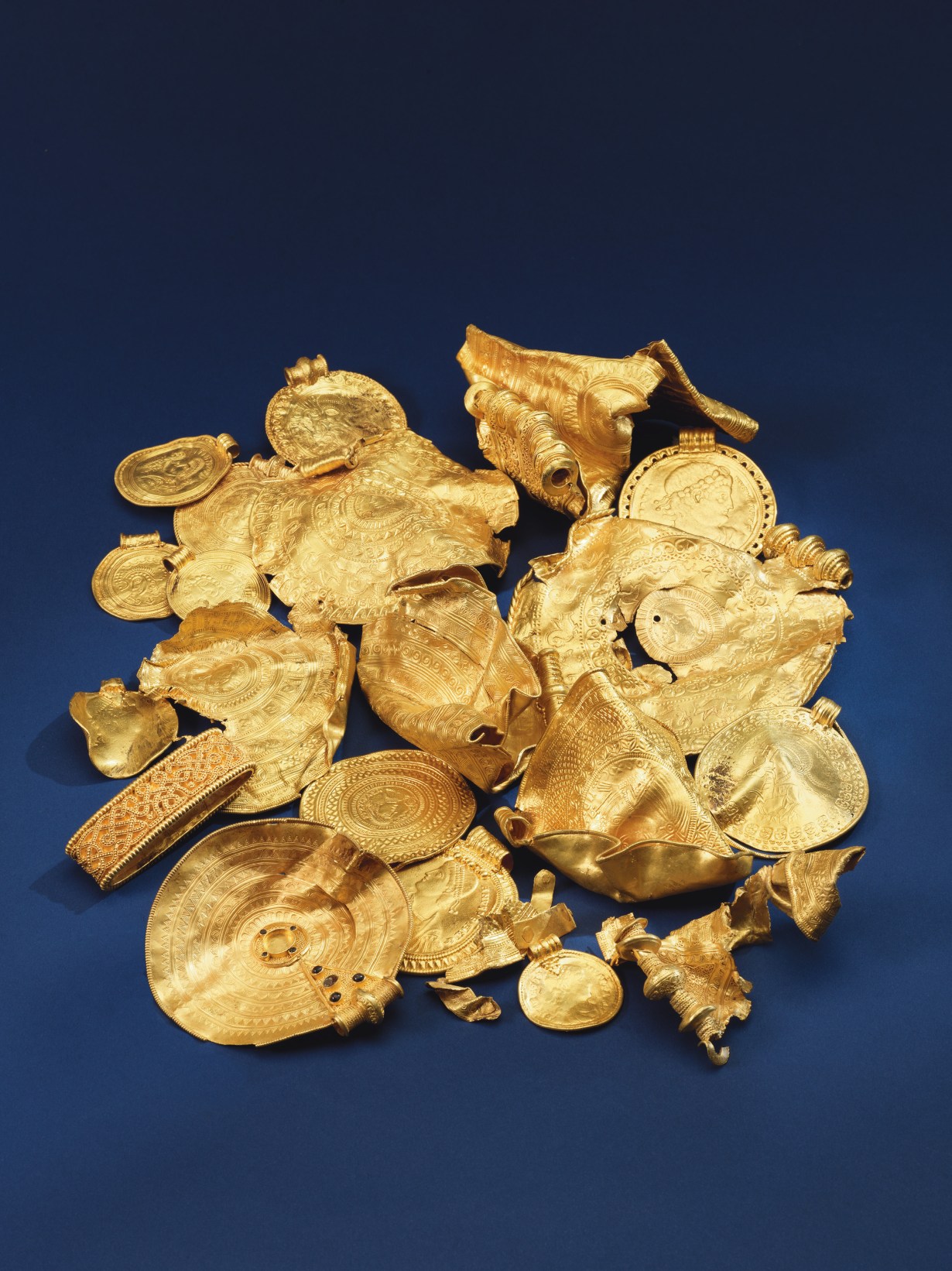 The Vindelev Hoard was discovered in Denmark in December 2020. It comprised numerous gold artefacts in the form of local pendants, Roman medallions, and ornate fittings. The hoard is currently on display at the National Museum of Denmark, Copenhagen.Image: National Museum of Denmark, photo by Arnold Mikkelsen, CC-BY-SA
The Vindelev Hoard was discovered in Denmark in December 2020. It comprised numerous gold artefacts in the form of local pendants, Roman medallions, and ornate fittings. The hoard is currently on display at the National Museum of Denmark, Copenhagen.Image: National Museum of Denmark, photo by Arnold Mikkelsen, CC-BY-SAMetal-detecting in Denmark
Metal-detection is legal in Denmark, provided one has the permission of the landowner and the machine is used at least 2m away from protected heritage monuments and sites. Objects older than 400 years and/or of exceptional value are characterised as ‘Treasure Troves’ and must be given to the National Museum, with the finders receiving compensation for their discoveries. This approach has significantly contributed to heritage preservation and public engagement, leading to a sharp rise in reported finds. To support these efforts, the DIME (Digitale Metaldetektorfund) was developed between 2016 and 2018 as a user-driven portal by a consortium of institutions (Aarhus University, Moesgaard Museum, North Jutland Historical Museum, and Odense Museum) in collaboration with detector users. The portal enables metal-detectorists to register their discoveries, enhancing data collection through crowdsourcing and reducing museums’ workload in find registration, promoting a more democratic and inclusive approach to heritage management.
For more information, visit the website http://www.metaldetektorfund.dk/ny/.
An unexpected discovery
In December 2020, Ole Ginnerup Schytz unearthed the hoard using his new metal-detector in a field owned by his friend Jørgen Antonsen near Vindelev, approximately 10km from the modern town of Vejle and 8km from the 10th-century royal centre at Jelling (see box below). The items retrieved from the field included 13 bracteates, a fragment from the border of another bracteate, four Roman medallions, a pendant with glass inlays, and a scabbard mount. They were probably deposited together, and had a total weight of nearly 800g of gold. Subsequent excavations carried out by the Museum of Vejle revealed that the finds had been recovered from a layer disturbed by agricultural activity, but were mostly concentrated within an area inside the walls of a longhouse dating to the Migration Period (4th to 6th centuries AD). Similar discoveries from other sites in Denmark, particularly in southern Jutland, Funen, and Zealand, indicate that it was common practice in the period to bury hoards inside houses. Although the place name ‘Vindelev’ predates the Viking Age, there had previously been no significant archaeological finds in the area dating to before the establishment of Jelling. Therefore, the elite character of the hoard immediately raises the question of whether Vindelev may have acted as a prominent centre in the area, perhaps even a precursor to nearby Jelling.
Initial analyses of the artefacts were carried out by the National Museum of Denmark, in Copenhagen, with further research – including 3D-scanning – undertaken at the Technical University of Denmark (DTU). A major challenge has been that some of the bracteates are folded so tightly that the motifs and runic inscriptions on one side of them are obscured. As manually unfolding the delicate gold poses a high risk of damage, the National Museum of Denmark and the Museum of Vejle turned to advanced imaging technologies at DTU to examine the objects non-invasively. The objects are now at the National Museum of Denmark, where they form part of the permanent exhibition. Selected items have also been included in temporary displays, such as the exhibition Power and Gold – Vikings in the East at the Museum of Vejle in 2022, and Gold Treasures from Vindelev at Kongernes Jelling – Home of the Viking Kings, in 2025.
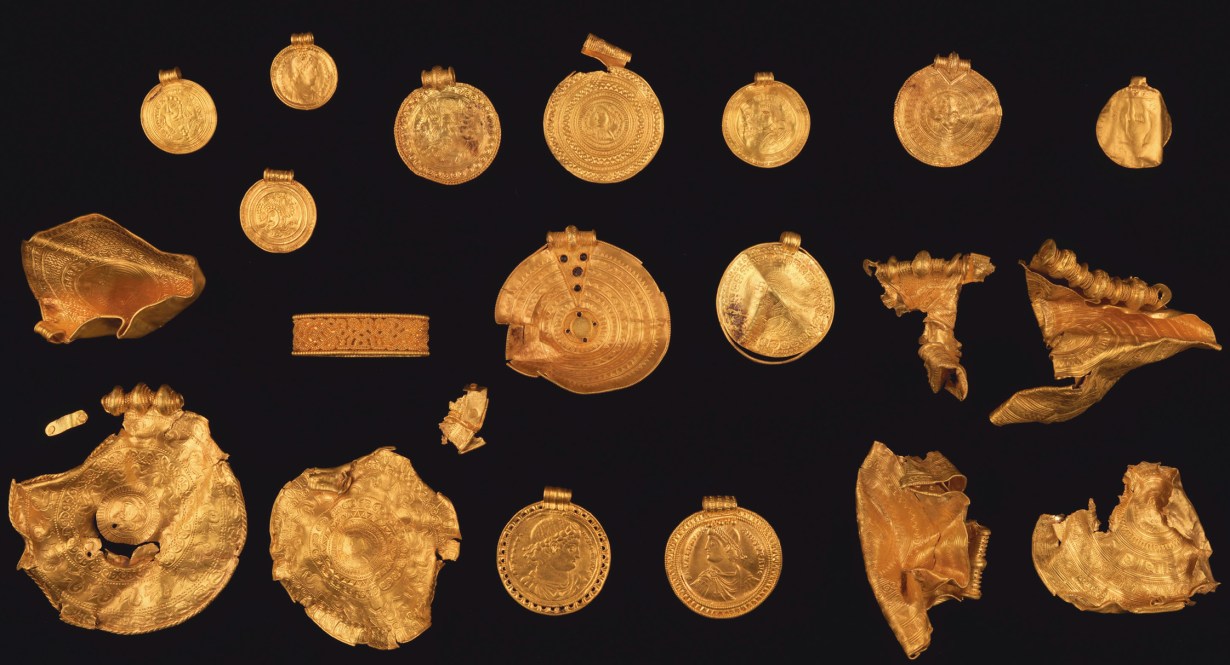 The individual components of the Vindelev Hoard. Note the varying size of the bracteate pendants. Image: National Museum of Denmark, CC-BY-SA
The individual components of the Vindelev Hoard. Note the varying size of the bracteate pendants. Image: National Museum of Denmark, CC-BY-SARoyal Jelling
Jelling was a royal seat in the 10th century, and it is especially famous for two monumental stones. The smaller of the two (below) was set up by King Gorm ‘the Old’ honouring Queen Thyra, who is described as ‘Denmark’s adornment’. This is the first attestation of Denmark as a country under one ruler. Another first recorded at Jelling is that of the country’s Christianisation: Harald Bluetooth, son of Gorm and Thyra, proclaimed on the largest of the stones that he ‘made the Danes Christian’. He also raised two burial mounds for his parents, which still survive today. The wooden palisade that once enclosed the site is now evoked by white poles, while the positions of stones creating the outline of a ship are marked by white tiles on the ground. The archaeological complex is now an UNESCO World Heritage Site (https://whc.unesco.org/en/list/697).
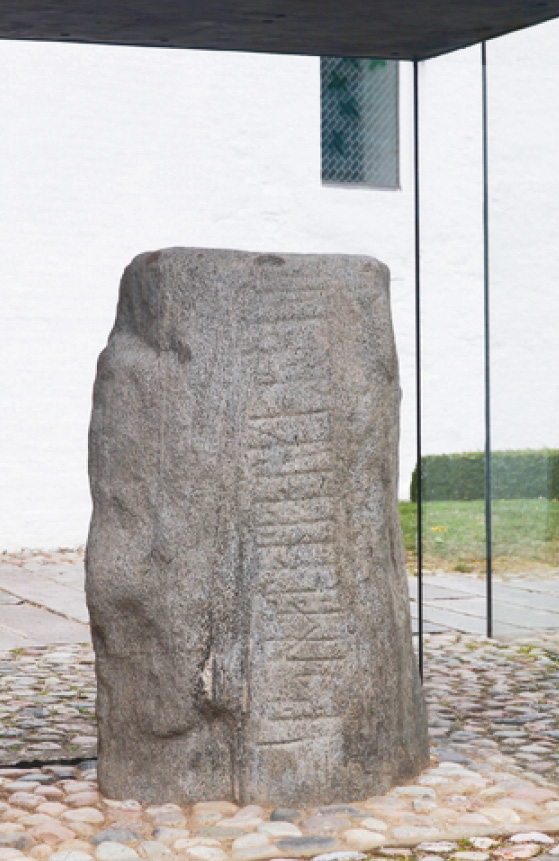 Image: © Ricochet69 | Dreamstime.com
Image: © Ricochet69 | Dreamstime.comThe hoard in the local context
The bracteates form the largest part of the Vindelev Hoard and stand out for their impressive size and fine craftsmanship – one example is in fact the largest of its kind known to date. Bracteates were typically worn as jewellery, but imbued with symbolic or religious significance. Produced predominantly in Northern Europe during the 4th to 6th centuries AD, they were made from thin gold foil, and stamped with dies to create stylised imagery. These often included mythological motifs featuring animals, human-like figures, and runic inscriptions, which were believed to function as protective amulets or to channel divine power. Rather than currency, they were personal objects reflecting status and belief. More than a thousand bracteates have been discovered across Northern Europe in hoards and burial sites, providing valuable insights into pre-Christian culture and artistic traditions. The central and eastern portions of Funen, an island in Denmark, represent the richest areas for gold finds from the Migration Period, and may have been the region where gold bracteates were first developed. Notable discoveries include the bracteates from Gudme on Funen and those from Bornholm and Zealand.
Bracteates are typically classified into four types based on their iconography (Types A-D), with type A (a human face and/or bust) considered to reflect Roman imagery on coinage. By contrast, types B, C, and D, which combine animal and human forms (Type B), or a human over a quadruped (Type C), or just stylised animals (Type D), reflect Northern European/Scandinavian iconography. The Vindelev bracteates belong to Type A and Type C (nine and four specimens respectively) and are remarkable for their extraordinary size and weight. Whereas a typical bracteate weighs between 2g and 7g, the 13 examples from Vindelev have a combined weight of an impressive 576g – equivalent to around 100 standard examples. One, in particular, stands out, with a 13.8cm diameter and 123.7g weight, making it the largest known to date. These bracteates are not only larger and heavier, but also more elaborately decorated than most others, suggesting that they belonged to one or more individuals of very high status. This impression is further reinforced by two additional items in the hoard: a circular pendant with glass inlays and a scabbard mouthpiece, both of exceptional craftsmanship.
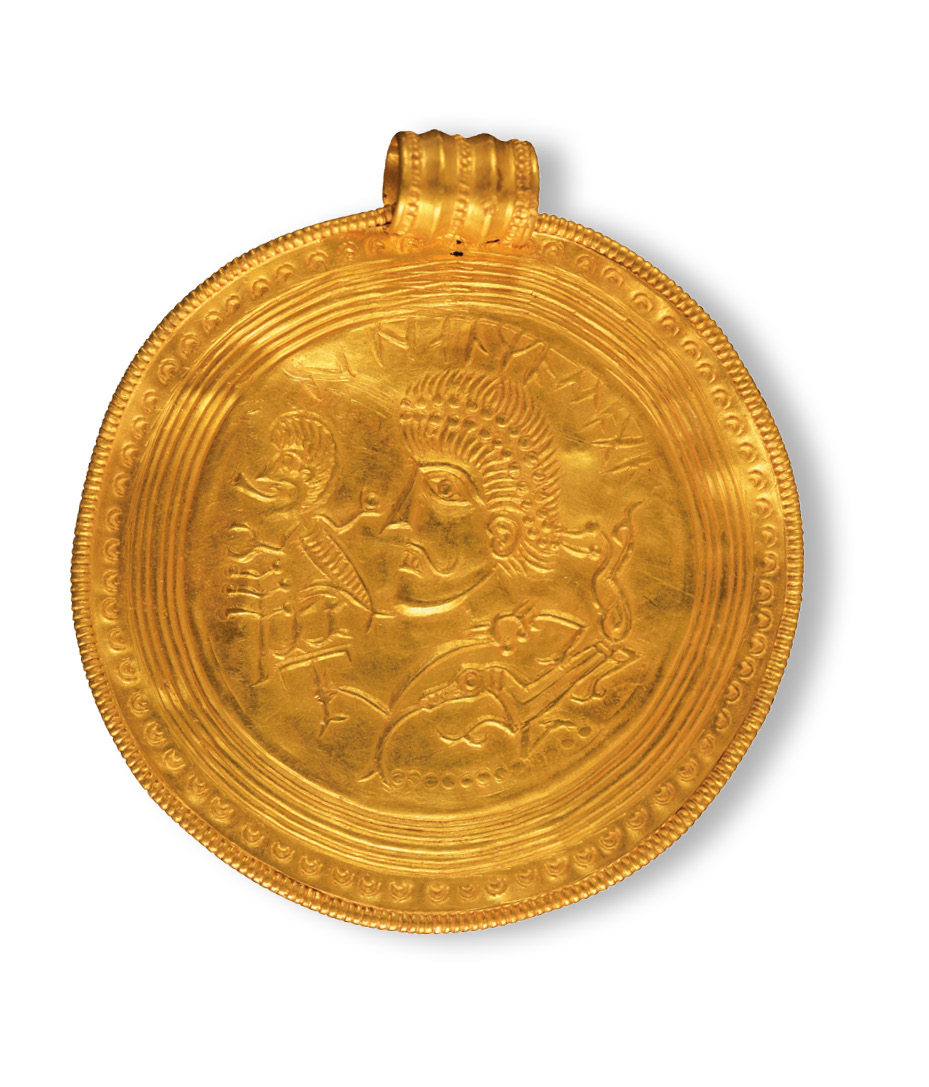 Bracteate IK 731 (Type C) is an example from the Vindelev Hoard that carries a runic inscription (5th century AD). Image: National Museum of Denmark, photo by Arnold Mikkelsen, CC-BY-SA;
Bracteate IK 731 (Type C) is an example from the Vindelev Hoard that carries a runic inscription (5th century AD). Image: National Museum of Denmark, photo by Arnold Mikkelsen, CC-BY-SA; The hoard closely resembles gold treasures found near Gudme on Funen, a key political centre from the 3rd to 6th centuries, while one of the bracteates is identical to an example found close to Odense, also on Funen. This has led to the suggestion that some of the Vindelev bracteates may have been made by a goldsmith in Gudme, indicating that the gold could have changed hands through alliance or marriage between ruling clans.
In terms of chronology, the objects span nearly two centuries. The Roman medallions date to the mid-4th century, the bracteates are from around AD 450- 490, and the scabbard mount probably originates from a few decades into the 6th century. These three distinct chronological groups suggest complex circumstances behind the accumulation and eventual burial of the hoard, which may have taken place in the mid-6th century. This act of deposition could have been a response to a volcanic eruption in AD 536, which is known to have caused significant climatic disruption and social upheaval across Europe. According to many scholars, the climate catastrophe led the local inhabitants to bury substantial amounts of gold, either to protect their wealth from enemies or as an offering to appease the gods during a time of crisis.
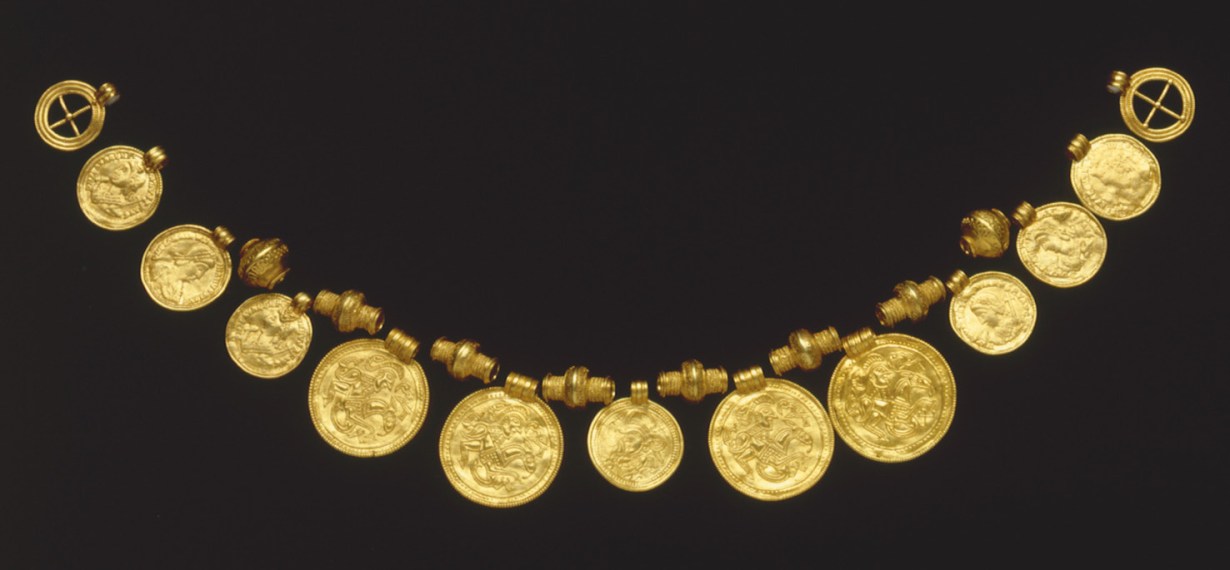 A necklace of bracteates, medallions, and pendants, that was found at Sorte Muld, on Bornholm. It is now in the National Museum of Denmark. Image: National Museum of Denmark, photo by John Lee, CC-BY-SA
A necklace of bracteates, medallions, and pendants, that was found at Sorte Muld, on Bornholm. It is now in the National Museum of Denmark. Image: National Museum of Denmark, photo by John Lee, CC-BY-SALinguistic and religious significance
Six of the gold bracteates bear runic inscriptions. Three of these inscriptions are already known from other identical or similar bracteates, while the remaining three are unique and not attested elsewhere. They offer significant insights into the Proto-Norse language, the development and use of writing, and the history of religion. Of particular importance is the inscription on a bracteate known to specialists as IK 738, which contains the earliest datable occurrence of the name of the god Odin. This inscription suggests that Odin was worshipped as early as the 5th century, pre-dating previous evidence by around 150 years.
Several Vindelev bracteates depict large human heads crowned with diadems and dressed in elements of Roman imperial regalia, such as consul’s robes and circular brooches. Combined with traditional northern traits like long, styled hair, these indicate that the bracteates represent a ruler evoking the iconography of Roman emperors. Whether the figure portrayed is earthly or divine remains uncertain, but the association with Odin is compelling.
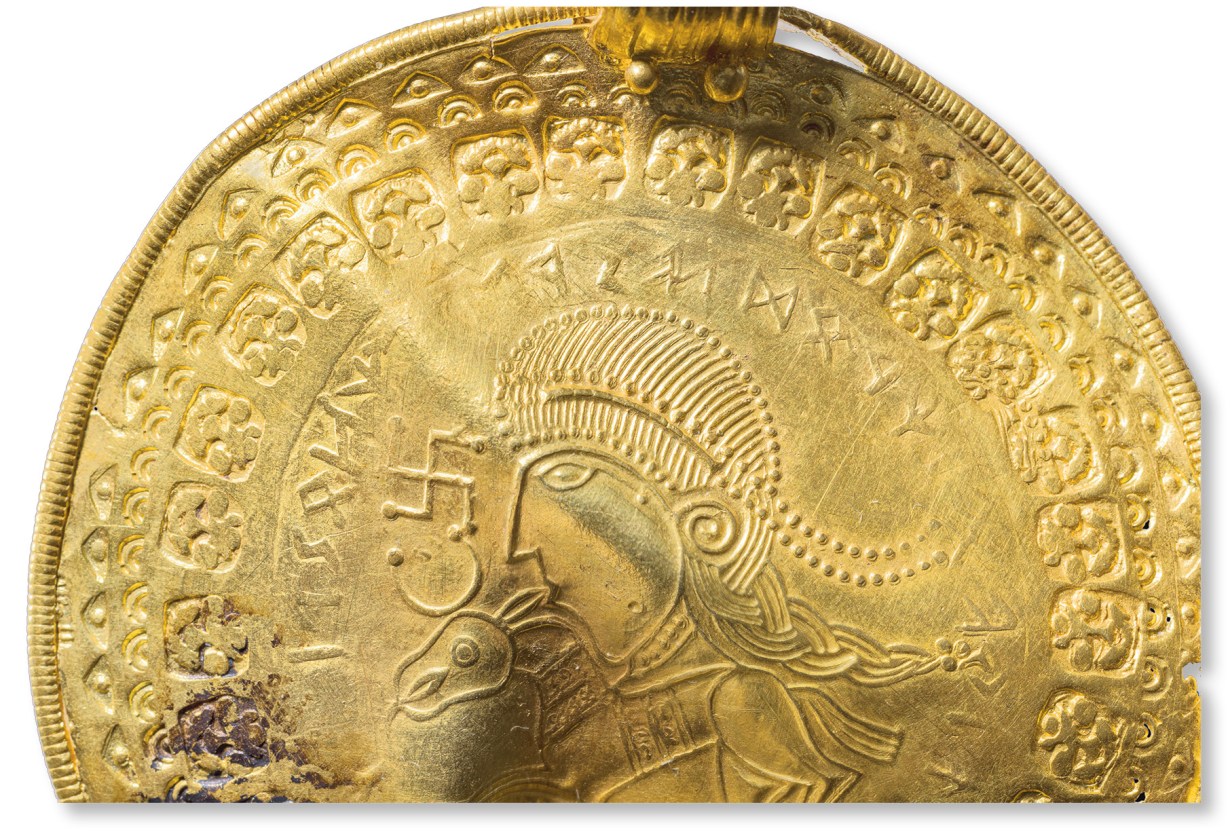 Bracteate IK 738 (Type C) from the Vindelev Hoard bears a runic inscription mentioning the name of the god Odin (5th century AD). Image: National Museum of Denmark, photo by Arnold Mikkelsen, CC-BY-SA
Bracteate IK 738 (Type C) from the Vindelev Hoard bears a runic inscription mentioning the name of the god Odin (5th century AD). Image: National Museum of Denmark, photo by Arnold Mikkelsen, CC-BY-SAPolitical connections
In addition to the bracteates, the hoard includes four Roman medallions (multipla) issued by the 4th-century emperors Constantine the Great, Constans, Valentinian I, and Gratian respectively. These were reworked into pendants by craftsmen working beyond the borders of the Roman Empire, reflecting long-distance movement and cultural exchange before their deposition at Vindelev. Remarkably, this is the first known discovery in Scandinavia to include more than one Roman medallion. The inclusion of four such objects in the hoard is particularly significant as these medallions probably relate to a broader network of elite individuals across Europe, with such objects possibly exchanged as bride payments or diplomatic gifts. The fact that these medallions were reworked into pendants outside the Roman Empire suggests that they passed through various hands before reaching Vindelev. One of the medallions bears the same mintmark as a medallion found in Zargorzyn, Poland, highlighting the extensive connections among European elites during this period.
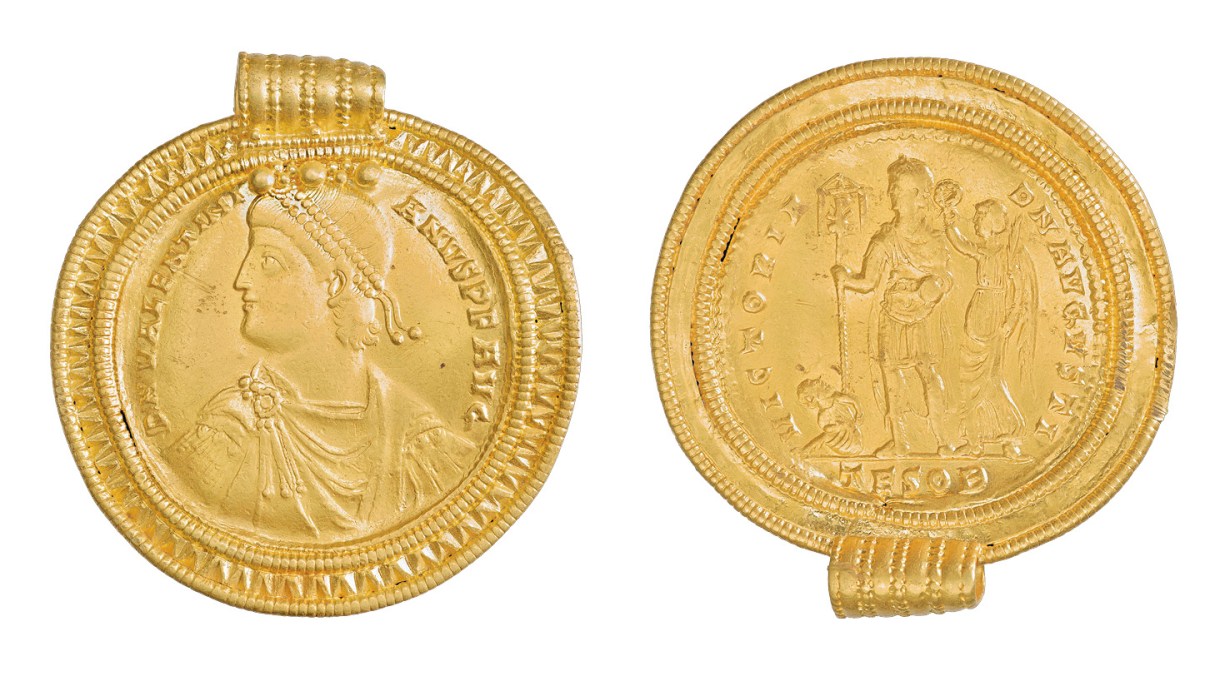 The obverse and reverse faces of a Roman medallion issued by Valentinian I (AD 364-375), from the Vindelev Hoard. Image: National Museum of Denmark, photos by Arnold Mikkelsen, CC-BY-SA.
The obverse and reverse faces of a Roman medallion issued by Valentinian I (AD 364-375), from the Vindelev Hoard. Image: National Museum of Denmark, photos by Arnold Mikkelsen, CC-BY-SA.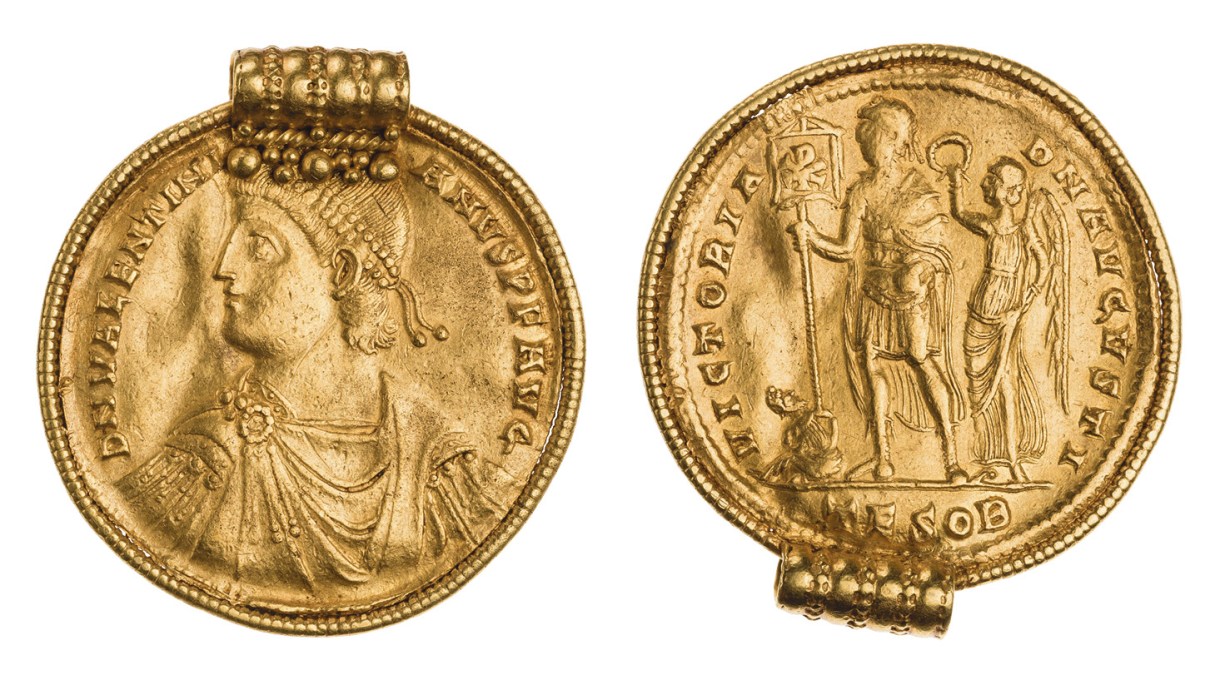 The two faces of another Roman medallion issued by Valentinian I. This example came from a hoard found at Zargorzyn, Poland, and has the same mintmark as one of the medallions found at Vindelev. It is now in the collection of the American Numismatic Society, New York. Image: American Numismatic Society (inv. 1967.153.76), photo by Aleksander Bursche, PDM
The two faces of another Roman medallion issued by Valentinian I. This example came from a hoard found at Zargorzyn, Poland, and has the same mintmark as one of the medallions found at Vindelev. It is now in the collection of the American Numismatic Society, New York. Image: American Numismatic Society (inv. 1967.153.76), photo by Aleksander Bursche, PDMDuring the 4th to 6th centuries, Denmark was a land governed by powerful clan leaders who ruled over distinct territories. Their authority was reinforced through warfare and wealth – the more victories they secured and treasures they amassed, the more followers they attracted. Given the remarkable size and richness of the hoard, it must have belonged to a powerful, though previously unknown, local leader, whose power centre lay at Vindelev.
Hoards such as that found near Vindelev underscore the interconnectedness of elite societies across Europe, and the role of material culture in expressing and maintaining social hierarchies. They also highlight the importance of such discoveries in enhancing our understanding of the past and challenging previous assumptions about the distribution of power and influence. As research progresses, the Vindelev Hoard offers vital clues about the religious practices, political structures, and elite networks that shaped 4th- to 6th-century Northern Europe.
Roman Archaeology beyond the fringes of the Empire
The next joint Roman Archaeology Conference/Theoretical Roman Archaeology Conference will take place 21-23 May 2026 at Aarhus University, Denmark. The event is organised by Aarhus University, UrbNet (Centre for Urban Network Evolutions), and the Museum of Ancient Art, in collaboration with the Roman Society and the TRAC Committee.
RAC/TRAC 2026 will bring together scholars from across the globe and feature a rich programme of thematic sessions showcasing cutting-edge research, including the latest approaches to urbanism and landscape, connectivity, archaeological archives, and the decolonisation of the discipline.
The Organising Committee is currently selecting the sessions that will form part of the final line-up. The Call for Papers for each session will be announced in mid-July 2025.
For updates, visit the websites http://www.romansocietyrac.ac.uk/ractrac-2026/ and https://urbnet.au.dk/news.
Further Reading:
• K Hauck, M Axboe, U Clavadetscher, K Düwel, H Lange, H Rulffs, U Smyra, L von Padberg, and C Wypior (1985-1989) Die Goldbrakteaten der Völkerwanderungszeit. Ikonographischer Katalog, Münstersche Mittelalter-Schriften, 24/1-3 (Munich: Wilhelm Fink Verlag).
• W Heizmann and M Axboe (eds) (2011) Die Goldbrakteaten der Völkerwanderungszeit: Auswertung und Neufunde, Ergänzungsbände zum Reallexikon der Germanischen Altertumskunde, 40 (Berlin and New York: De Gruyter).
• L M Imer and K S K Vasshus (2023) ‘Lost in Transition: the runic bracteates from the Vindelev Hoard’, NOWELE 76 (1): 60-99.
• M Ravn and C Lindblom (eds) (2022) Magt og guld: Vikinger i øst/Power and Gold: Vikings in the East (Aarhus: Vejlemuseerne and Turbine).
• D Skre (2025) The Northern Routes to Kingship: a history of Scandinavia AD 180-550 (New York: Routledge).
